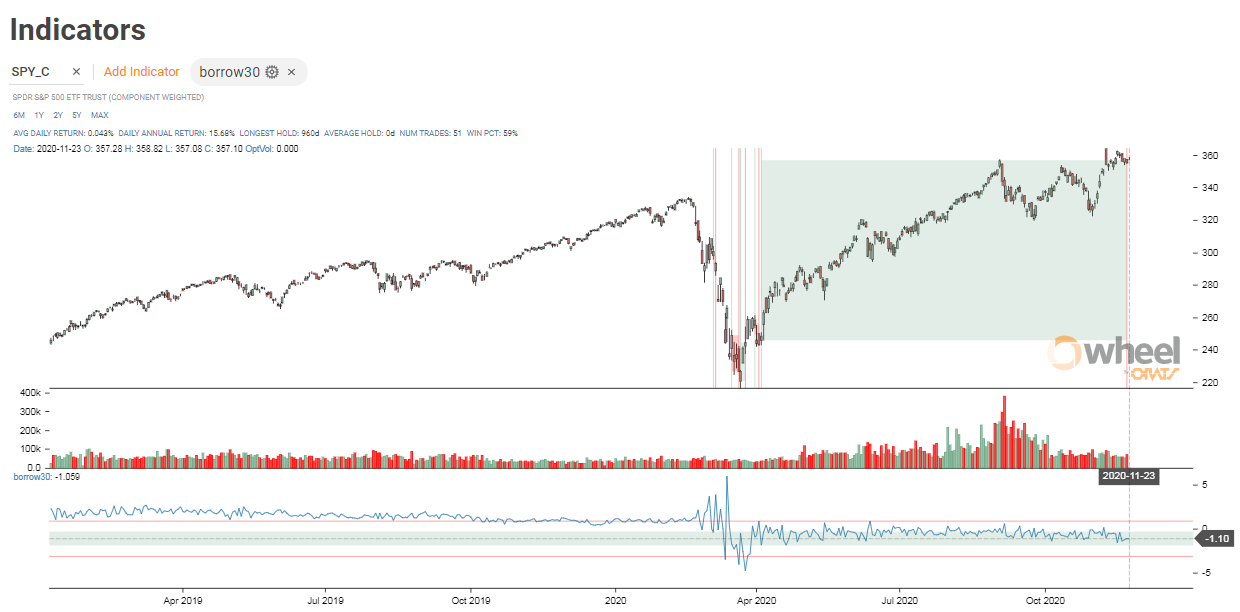Market Events
Monday, November 23rd 2020
Short Interest In S&P 500 Stocks Hit New Lows
Short interest in the S&P component stocks have hit a new low and so has the borrow rates. Borrow rates show the demand for shorting through an options put-call parity calculation.
Summary
Short interest in S&P 500 stocks has hit a new low, with the current short interest percent at 1.6%, the lowest since 2004. The borrow rate, which approximates the borrowing rate charged by brokers to lend stock for short selling, is also at a low of -1.1%, indicating high investor sentiment and few short sellers.
Short interest is the amount of shares in a stock that is sold short, and not covered, expressed in a percentage of a stock's market capitalization. When a stock is sold short, the stock is borrowed from a holder of the stock and sold. The borrow rate will rise if there are more short sellers and fall if there are fewer shorts.
Typically, the short interest percent is above 2%, averaging about 2 1/4% since 2004. The high in 2008 was just north of 3.5% and the low prior to 2020 was 2% in 2019. Currently, the short interest percent is 1.6% the lowest since 2004, as sourced from Goldman Sachs through The Daily Shot.
The borrow rate is closely related to short interest. The borrow rate is calculated by ORATS by solving for the residual yield left over after a put-call parity calculation. The borrow rate approximates the borrowing rate charged by brokers to lend stock for short selling.
A two-year graph of the borrow rate for the S&P 500 constituents weighted average below shows that for 2020 the borrow rate was well below the average pre-2020. Typically, the rate is 1.5% but currently the rate is -1.1%.

The lower the borrow rate, the lower the demand for borrowing stock and the lower the short interest. In the graph, around the Covid-crash borrow rates jumped around a bit: The widening of the market associated with the market tumult made the job of determining the residual yield difficult to pin down. When the dust settled the borrow rates had fallen well below the typical rates seen in 2018 and 2019.
Recently, the borrow rates have continued to fall. Borrow rates are commensurate with investor sentiment. The lower the borrow rates the higher the investor sentiment. The current market is certainly communicating that investors are still positive with their outlook. At least, very few are left to short this powerful move in the market.
Disclaimer:
The opinions and ideas presented herein are for informational and educational purposes only and should not be construed to represent trading or investment advice tailored to your investment objectives. You should not rely solely on any content herein and we strongly encourage you to discuss any trades or investments with your broker or investment adviser, prior to execution. None of the information contained herein constitutes a recommendation that any particular security, portfolio, transaction, or investment strategy is suitable for any specific person. Option trading and investing involves risk and is not suitable for all investors.
All opinions are based upon information and systems considered reliable, but we do not warrant the completeness or accuracy, and such information should not be relied upon as such. We are under no obligation to update or correct any information herein. All statements and opinions are subject to change without notice.
Past performance is not indicative of future results. We do not, will not and cannot guarantee any specific outcome or profit. All traders and investors must be aware of the real risk of loss in following any strategy or investment discussed herein.
Owners, employees, directors, shareholders, officers, agents or representatives of ORATS may have interests or positions in securities of any company profiled herein. Specifically, such individuals or entities may buy or sell positions, and may or may not follow the information provided herein. Some or all of the positions may have been acquired prior to the publication of such information, and such positions may increase or decrease at any time. Any opinions expressed and/or information are statements of judgment as of the date of publication only.
Day trading, short term trading, options trading, and futures trading are extremely risky undertakings. They generally are not appropriate for someone with limited capital, little or no trading experience, and/ or a low tolerance for risk. Never execute a trade unless you can afford to and are prepared to lose your entire investment. In addition, certain trades may result in a loss greater than your entire investment. Always perform your own due diligence and, as appropriate, make informed decisions with the help of a licensed financial professional.
Commissions, fees and other costs associated with investing or trading may vary from broker to broker. All investors and traders are advised to speak with their stock broker or investment adviser about these costs. Be aware that certain trades that may be profitable for some may not be profitable for others, after taking into account these costs. In certain markets, investors and traders may not always be able to buy or sell a position at the price discussed, and consequently not be able to take advantage of certain trades discussed herein.
Be sure to read the OCCs Characteristics and Risks of Standardized Options to learn more about options trading.
Related Posts



